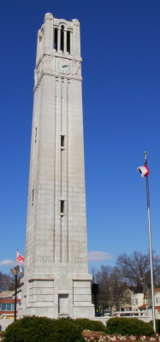 |
On the SW corner of the traffic circle where Pullen Rd. intersects with Hillsborough Rd.
It's near their belltower at the same point of the intersection. |
North Carolina State University in Raleigh is a large state university in Raleigh, NC. Their students and alumni bleed red and cheer for the Wolfpack. As a Tar Heel, I'm kind of *meh* about it; though they've had teams in football and basketball that have raised their rivalry profile, their matchups against Carolina don't garner the same enthusiasm from Tar Heels. But I will save that for later in the post. Right now, their famous NCS logo is colored red in honor of the state bird, the Cardinal. The block S has been used in variation since 1890, but it's design as seen below was first used in 2006. The Wolfpack was first adopted as its nickname and mascot in 1921, but names such as the Techs, the Aggies, and the Red Terror have been used prior to that adoption. It is said that the Wolfpack adoption was from a disgruntled fan describing the behavior of some of the school's football players as being "
as unruly as a pack of wolves". At sporting events, you'll see "Mr. and Mrs. Wuf" walk among the fans, but since 2010, they have a Tamaskan dog named "Tuffy" as their live mascot.
As an academic institution, NC State (or sometimes State) has excellent standing as a vet school, and is an excellent choice if students are interested in the sciences (especially the applied versions), engineering, and medicine. It was first established in 1887 as a land-grant institution under the Morrill Act of 1862 (the official NC State History page says March 7, to be exact). The Wautaga Club of Raleigh was a group of local lawyers, businessmen, teachers, and doctors who wanted to advance the purpose of higher education be available to more than just the select few; why not have it be open to the children of farmers and mechanics, for example? So the
North Carolina College of Agricultural and Mechanical Arts was born. Some of the local men associated with the Watauga Club are noted, such as Charles W. Dabney, William J. Peele, and Walter Hines Page. If a State fan/historian knows more about these men, they should let me know, because I certainly don't know how they are important to the campus! Classes began in 1889 for 72 students in one building. Hey, gotta start somewhere, right? But it's nowhere near the 31,000 students they teach today!
 |
| Official NC State Seal featuring the Bell Tower on Hillsborough Road |
In the 20th century, the federal government passed the Smith-Lever Act of 1914, creating an educational partnership between land-grant universities and the USDA (Department of Agriculture). This new law aimed to encourage faculty and staff to connect with farmers in order to provide practical agricultural instruction; NC State created their own version of the program under this law called the
Cooperative Agricultural Extension Service. Through this century, it has changed its name to State College, and then to its current name. The G.I. bill has helped the campus and student body grow immensely after World War II, and it is now considered a top school for agricultural, medical, and engineering sciences. In 1987, they built the Centennial Campus to link together the school, the students, and corporate partners to help further their education programs.
 |
The Memorial Tower, in honor of the NC State alumni who have fallen in World War I.
Commonly known as their Bell Tower. |
Sorry I don't have any more! I don't know much of their lore and traditions, as I've never identified with that campus. So if you have any more information, let me know and I'll update this post!




Comments
Post a Comment